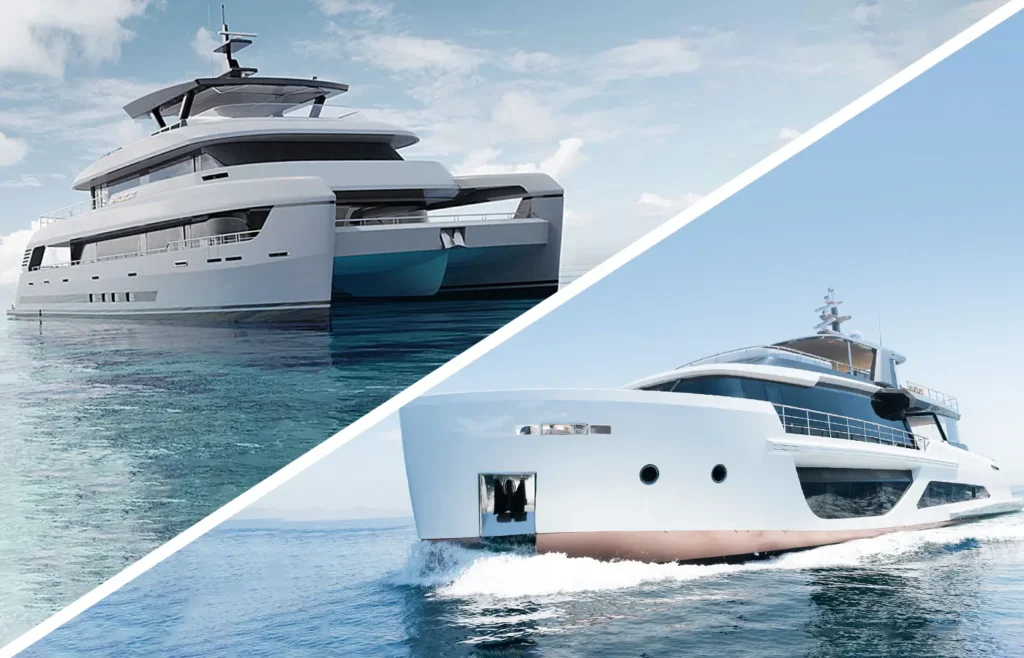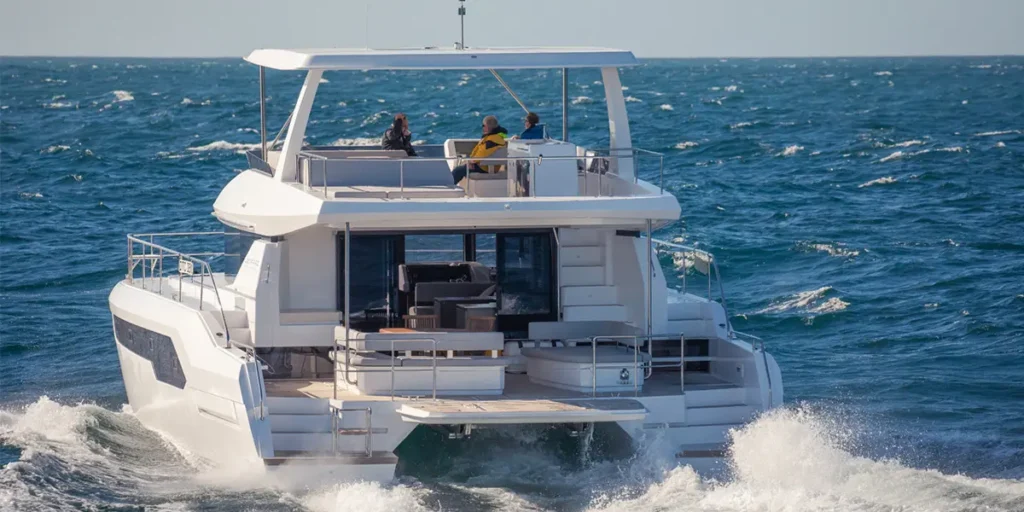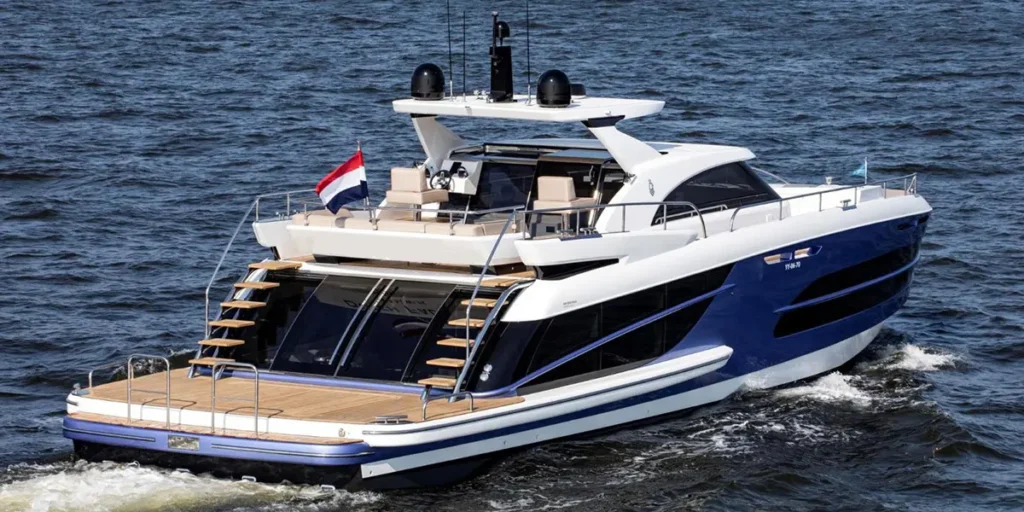
The debate over one or two hulls comes down to a number of factors with advantages and disadvantages to both. Ultimately, the decision to purchase a catamaran or monohull will be influenced by the buyer’s preference and intended use of the vessel. Florida yacht brokers Mike Kiely (Catamarans) and David Parkinson (Monohulls) take their respective sides.
Safety
Mike Kiely: Catamarans are very stable and have natural buoyancy, making them unsinkable. Yes, they can capsize in a bad accident, but it’s better to be rescued floating on the water’s surface than sinking to the bottom in a monohull. Moving around on a flat deck is much safer than on a deck at an angle.
David Parkinson: Monohulls have much better “self-righting” capabilities in the event of a worst case “knock-down” situation, particularly sailboats. Once you’re upside down in a catamaran, you stay upside down and who wants that in the middle of a large ocean? By returning to an upright position, you still have full access to onboard safety equipment: life raft, dinghy, floatation devices, EPIRBs, strobe lights, etc. to save you in the unlikely event of the boat sinking.
Speed
Mike Kiely: Cruising catamarans are faster than monohulls, and sailing catamarans can sail half the speed of the wind, depending upon their angle. It’s ideal to be on a boat that can reach high speeds quickly and arrive at your destination in a reliable and timely manner.
David Parkinson: Due to their lower wetted surface area, catamarans are certainly faster, but you pay a price with a slapping, uncomfortable ride. Monohull designs work harmoniously with the elements instead of trying to fight them. Sailing catamarans are inefficient upwind and tack very slowly.
Fuel

Mike Kiely: Want to save money on fuel? Get a catamaran. Since catamarans have reduced wetted surface on their hulls, they are much more fuel-efficient. In low winds, they can use just one engine to propel the boat.
David Parkinson: Catamarans are more fuel-efficient in flat water, assuming equal number and horsepower of engines; however, this is not the case in heavier weather, where the higher efficiency of monohull hull designs present less resistance.
Layout
Mike Kiely: The biggest perk is having all rooms on the same level. Most cruising cats have a 4-cabin layout, popular for charter companies. “Owner versions” typically have 3 cabins, using one hull as a large cabin, which is great for entertaining. Monohull layouts are inconvenient and not as spread out.
David Parkinson: Most catamarans have a large central living area with cramped staircases, one on either side to get down into the hulls. The spaces in the hulls feel a bit like living in a tube. They are narrow and can’t accommodate walk-around double/queen berths commonly found in monohulls.
Maneuverability

Mike Kiely: Catamarans are extremely maneuverable with their twin engines. Having two engines approximately 20 feet apart eliminates the need for a bow thruster. They also have shallow drafts, so you can navigate into places where you can’t with a monohull as well as anchor closer to shore.
David Parkinson: Monohulls maneuver better because you’re not dealing with two hulls. They can take sharper turns and navigate easily through narrow channels and tight spaces. Their higher hull displacements reduce the adverse effects of cross winds in tight conditions.
Docking
Mike Kiely: While it’s easy to dock a catamaran, the unique size doesn’t always fit into a traditional slip, but with some skill and careful planning, there shouldn’t be a problem finding space. You could also anchor or moor the boat and take a dinghy to the dock, which is even easier to dock than a monohull.
David Parkinson: Who wants to take two separate boats to a dock? A monohull is much easier to dock, takes up less space, and is cheaper to dock, haul, and slip.
Maintenance

Mike Kiely: With catamarans there is two of everything, so that’s certainly a trade-off of maintenance cost to reliability and redundancy. A huge benefit of having two of everything is you usually can still use the boat if one component isn’t working since you have a “back-up”. For example, you can typically run on one engine if the other fails.
David Parkinson: While redundancy is great, I’ll take reduced maintenance and repair costs any day. Two of everything certainly gives you good “back-up,” but if one of the two hulls isn’t working, you won’t want to take the boat out.
Stability
Mike Kiely: Catamarans have little to no heeling due to their weight bearing, and they do not roll at the anchor. Heeling on a monohull with unexpected gusts can be dangerous and uncomfortable, not to mention cause seasickness.
David Parkinson: The trade-off, again, is a noisy ride and a quick motion, which many people find uncomfortable in heavier weather. In a monohull sailboat, the heeling action actually provides stability, spills wind from the sails, and provides greater safety.
Comfort

Mike Kiely: The ability to walk around most of the boat and entertain guests without rocking is more comfortable on a catamaran, making them very family-friendly. Did you know that seasickness is slim to none on a catamaran?
David Parkinson: Fortunately, I’m not prone to seasickness, but I once felt very seasick on a sailing catamaran. Entertaining on a catamaran is often more comfortable because the platform is stable. But, after a couple of gin and tonics, it doesn’t seem to matter as much for some reason.
Cost
Mike Kiely: With a minimum of two of everything, cost can run high. Catamarans have a great resale value and a very low depreciation rate due to their popularity. They usually sell faster than monohulls. Since most catamarans are not built in the U.S., there are delivery costs involved when purchasing the boat.
David Parkinson: Catamarans are definitely increasing in popularity, and as a result of strong demand, they command higher prices in both new and brokerage markets. Maintenance costs, which are significantly higher than for a monohull, need to be factored in when making a buying decision.